Why you can trust Tom's Hardware
Asus GeForce RTX 5060 Ti 16GB Prime OC
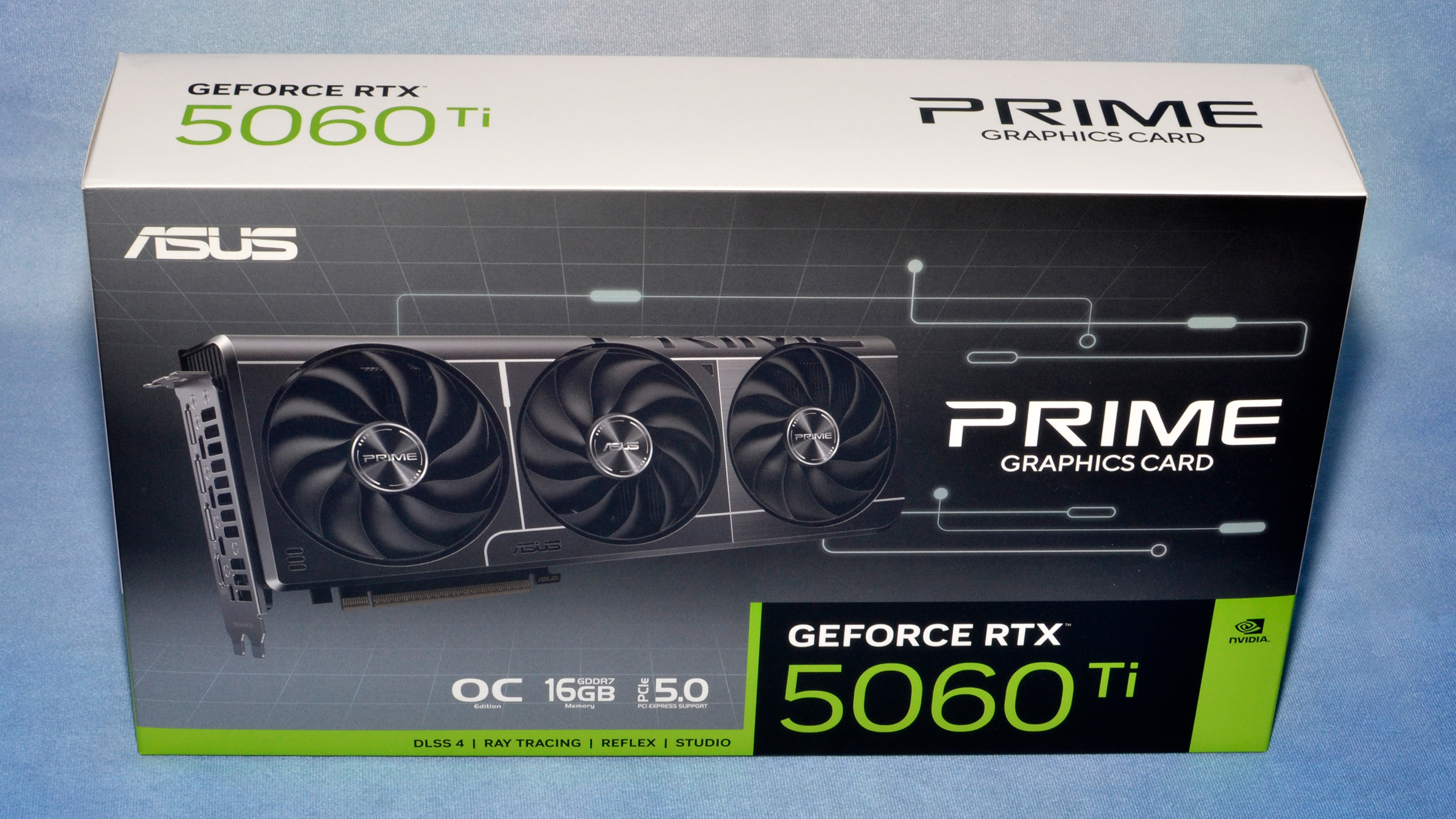
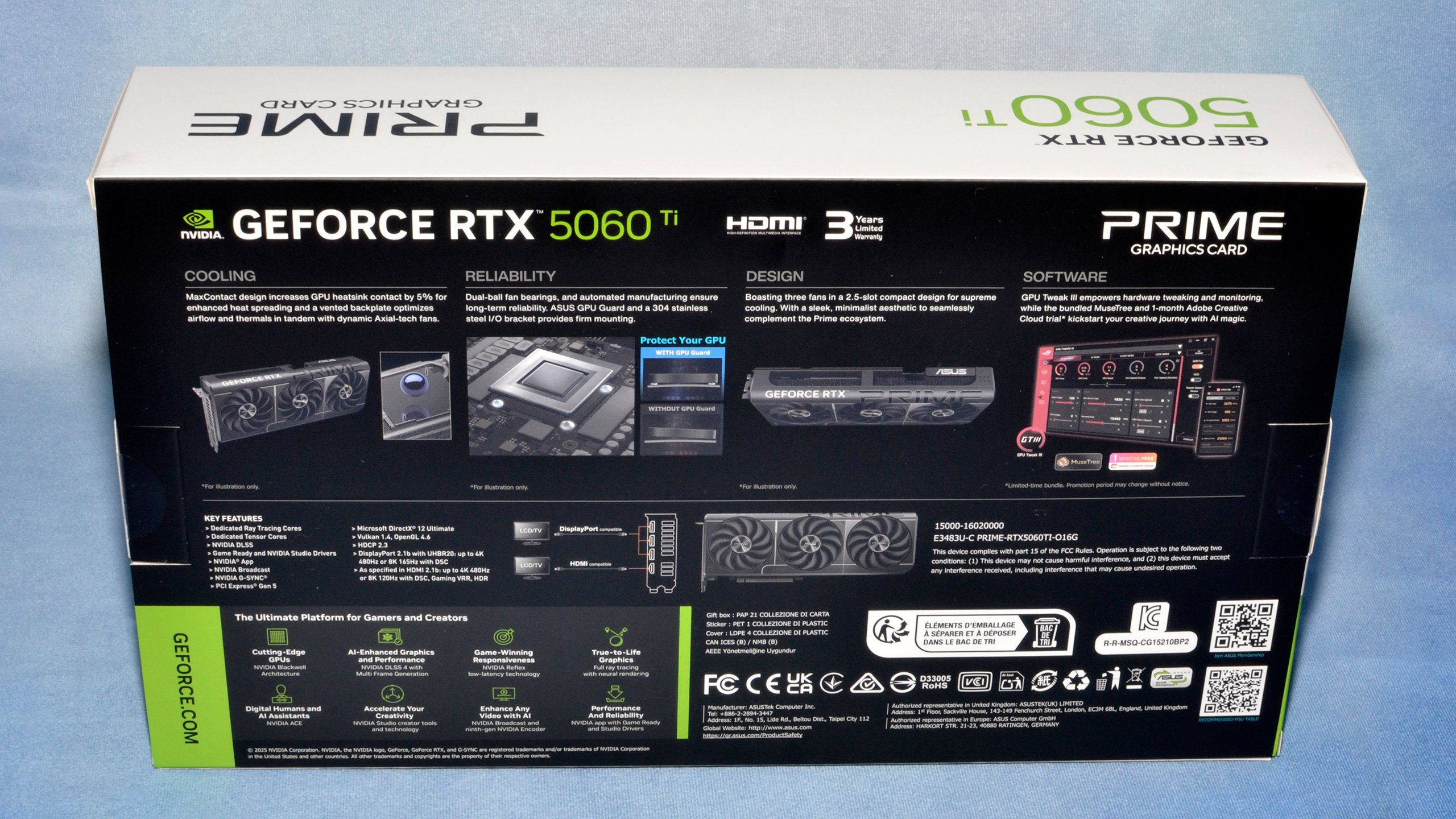
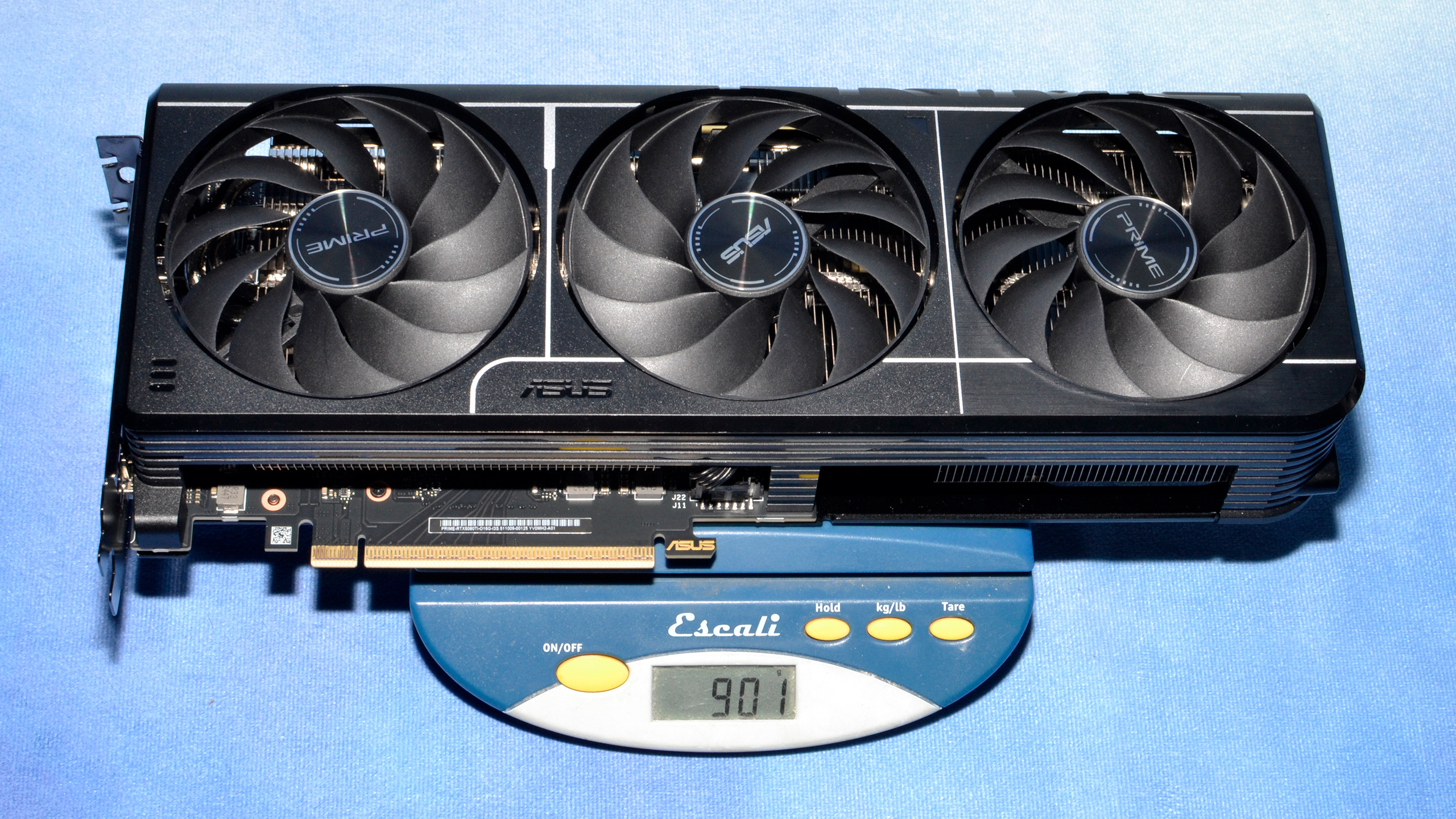
We received two different RTX 5060 Ti 16GB cards for today's launch. Asus sent its RTX 5060 Ti 16GB Prime OC, and Nvidia sent a PNY RTX 5060 Ti 16GB OC. We'll start with the Asus card.
The Prime series of graphics cards (and motherboards) represents more of a base feature set from Asus. That's not to say there are no extras, but you don't get RGB lighting and the overall design aesthetic trends toward the minimalist side of the spectrum. That's totally fine if you prefer less bling and doesn't reflect on the overall card quality.
The Prime OC comes with a relatively minor factory overclock of 2617 MHz out of the box. If you install Asus' GPU Tweak III software and enable the OC mode, you get another 30 MHz increase to the boost clock — which you can enable on any graphics card as far as we can tell. We tested without GPU Tweak III installed or running, as the additional gains from 30 MHz would be very minor. (It's only an additional 1.1% overclock, which is practically margin of error for many of our tests.)
The Prime OC comes with triple fans, each 89mm in diameter with an integrated rim that helps improve static pressure and airflow. Each fan has eleven blades, which is supposed to reduce noise (relative to fans with fewer blades), improve airflow, and eliminate turbulence. The middle fan also spins in the opposite direction of the outer fans to reduce air turbulence.
As you'd expect with a triple-fan design, the Prime OC isn't particularly small, though it does qualify for Nvidia's "SFF Ready" requirements. It weighs 901g and measures 304x120x50 mm. That's a 2.5-slot thickness, for a 180W TGP graphics card. You could say it's overkill, but the benefit will be cooler temperatures and less noise from the fans.
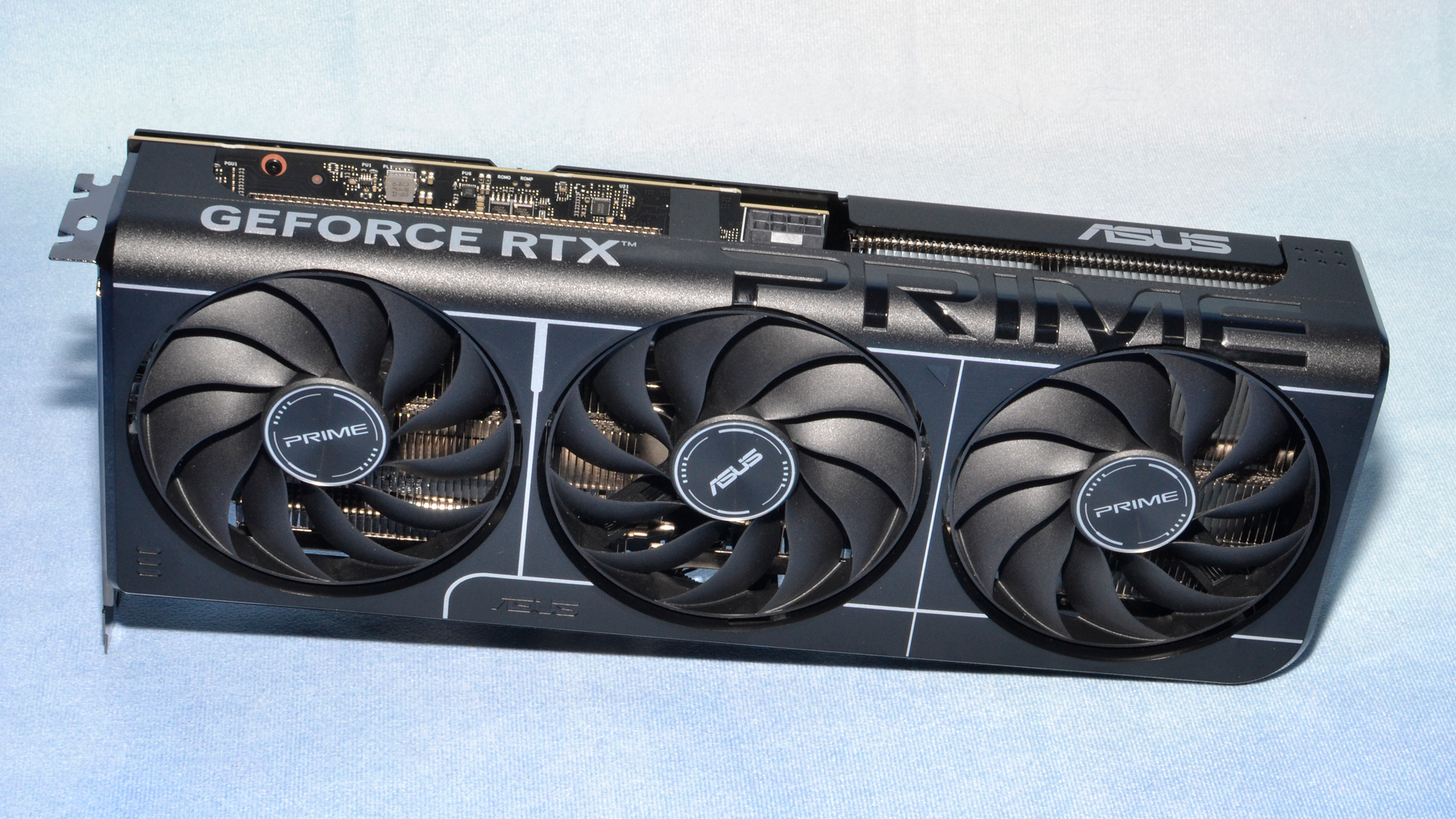
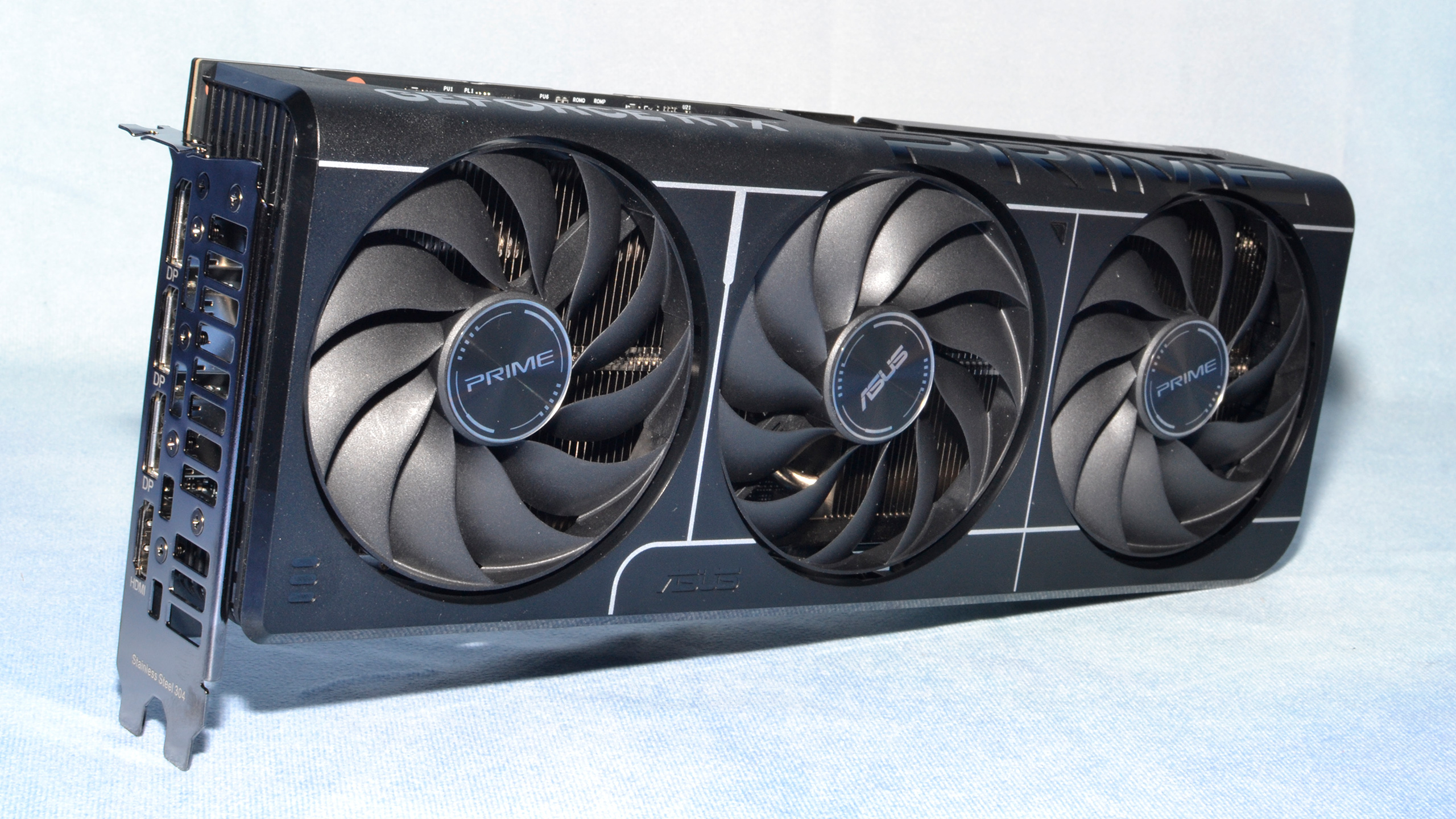
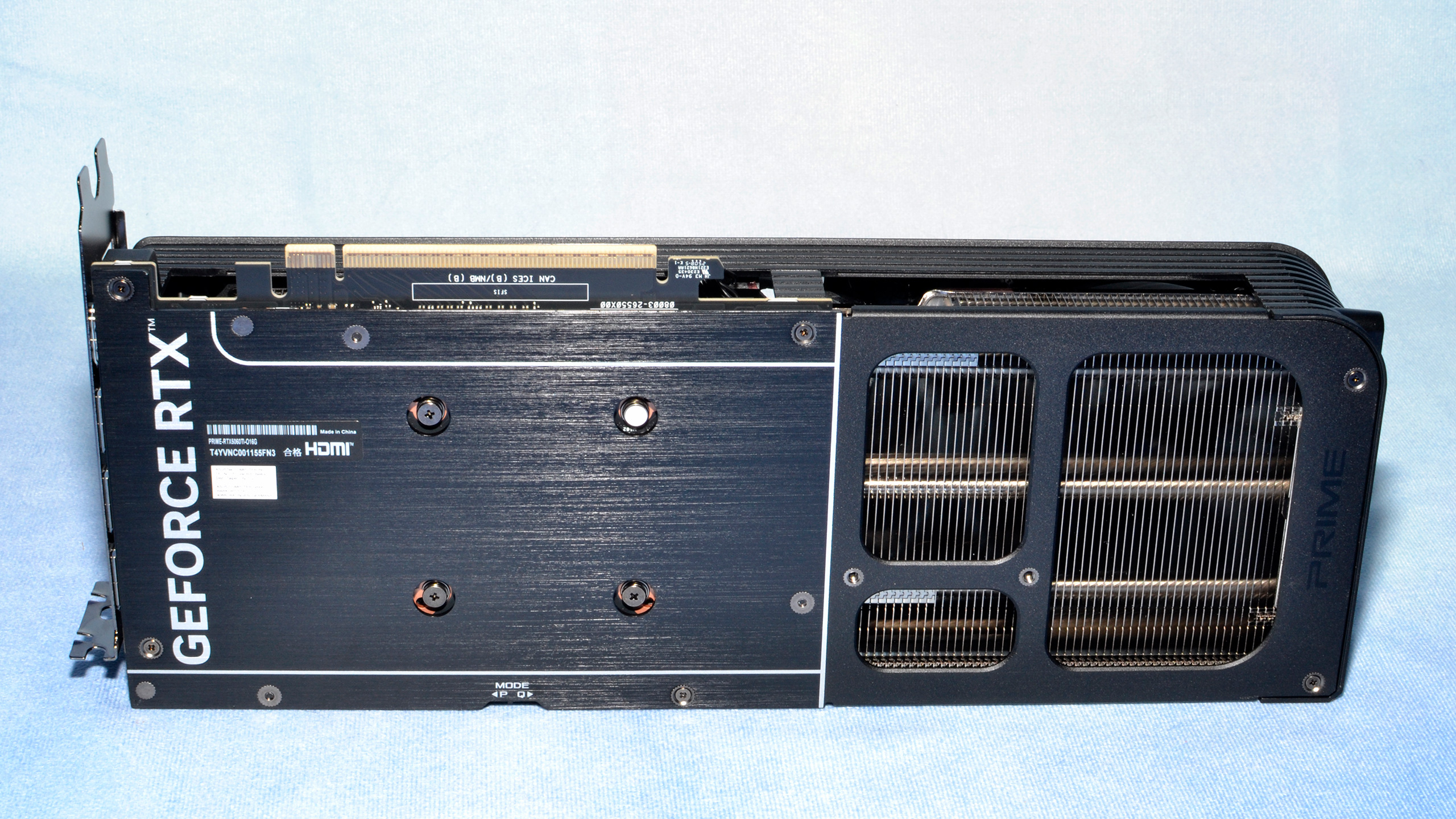
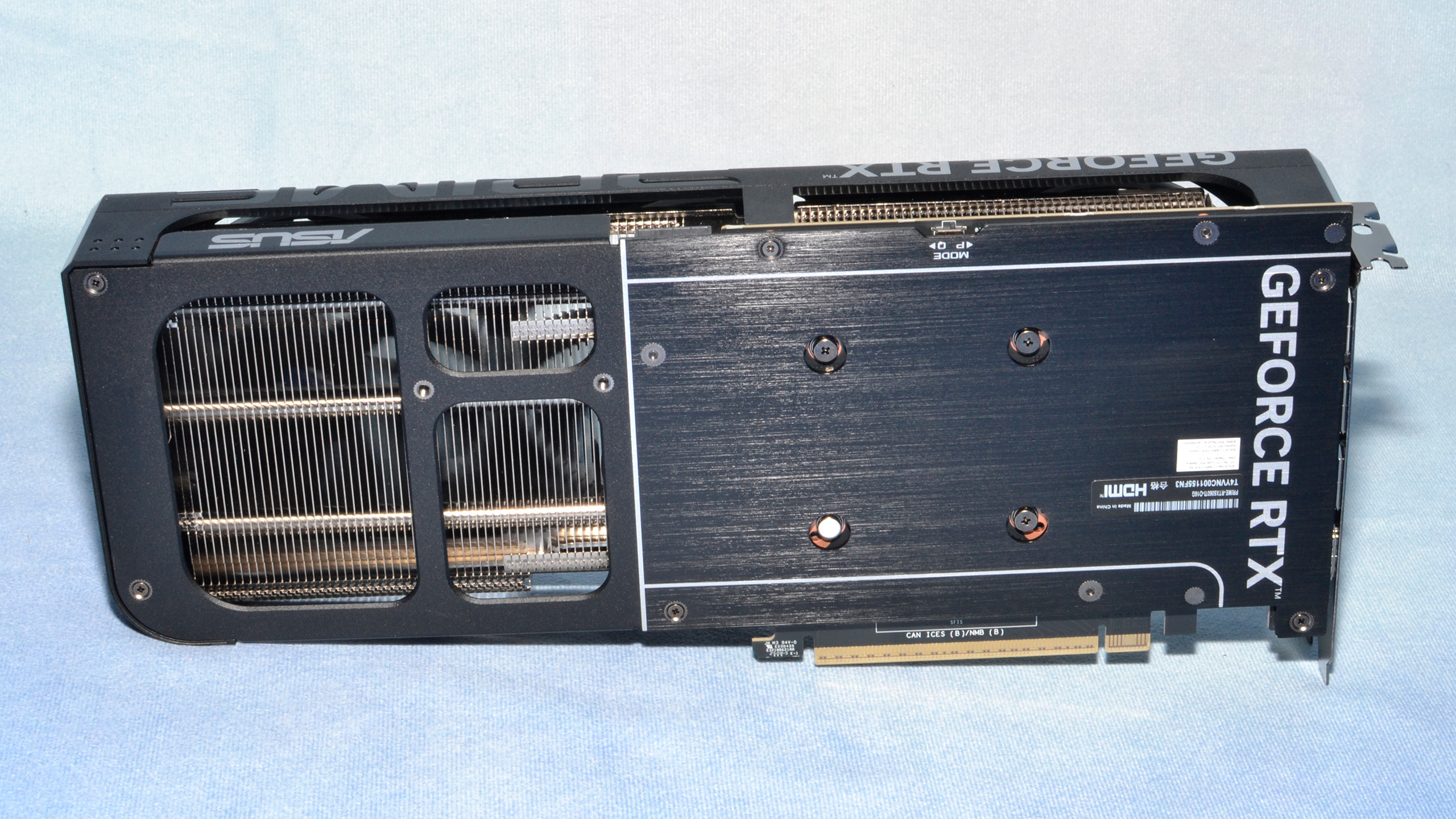
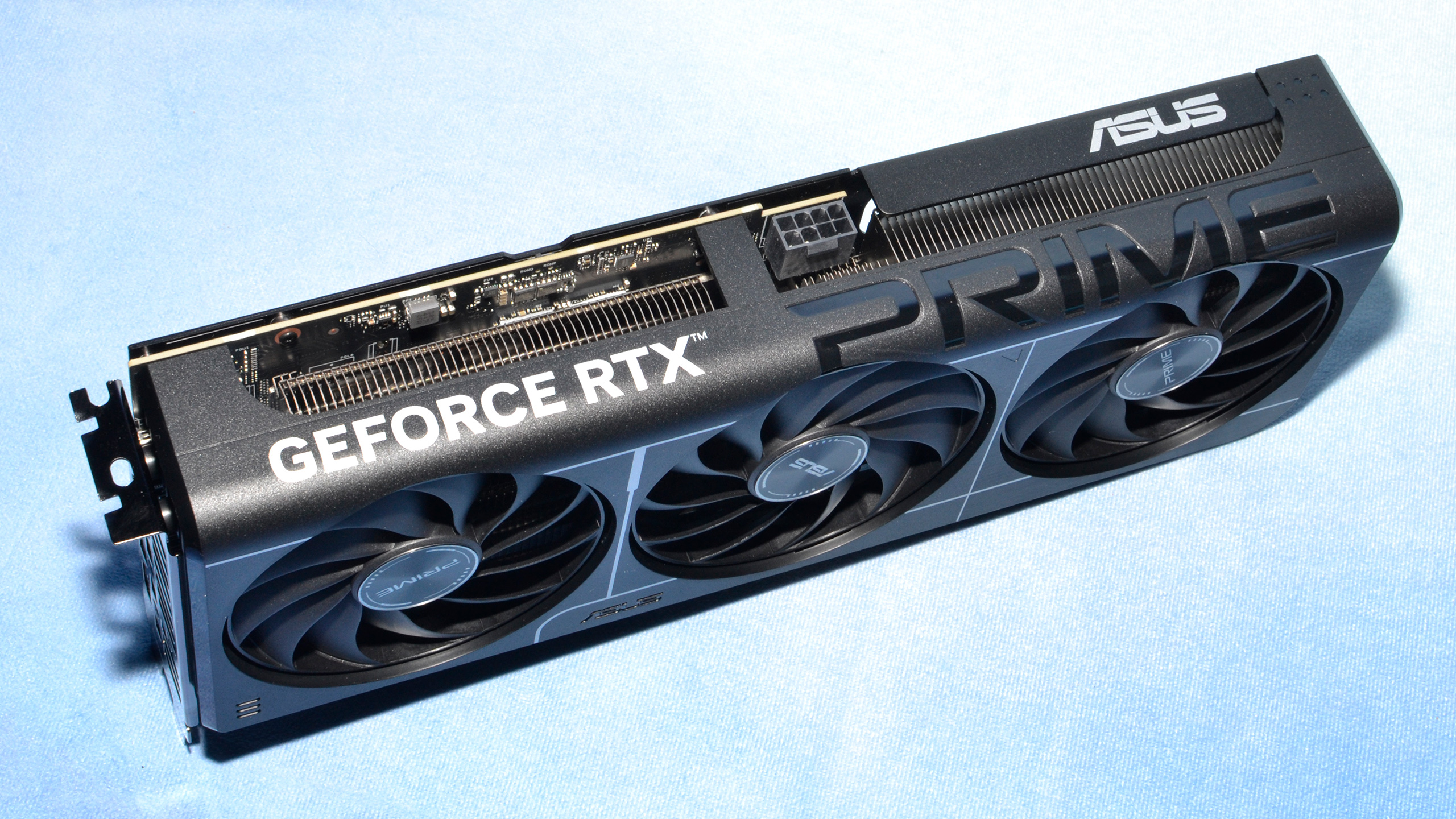
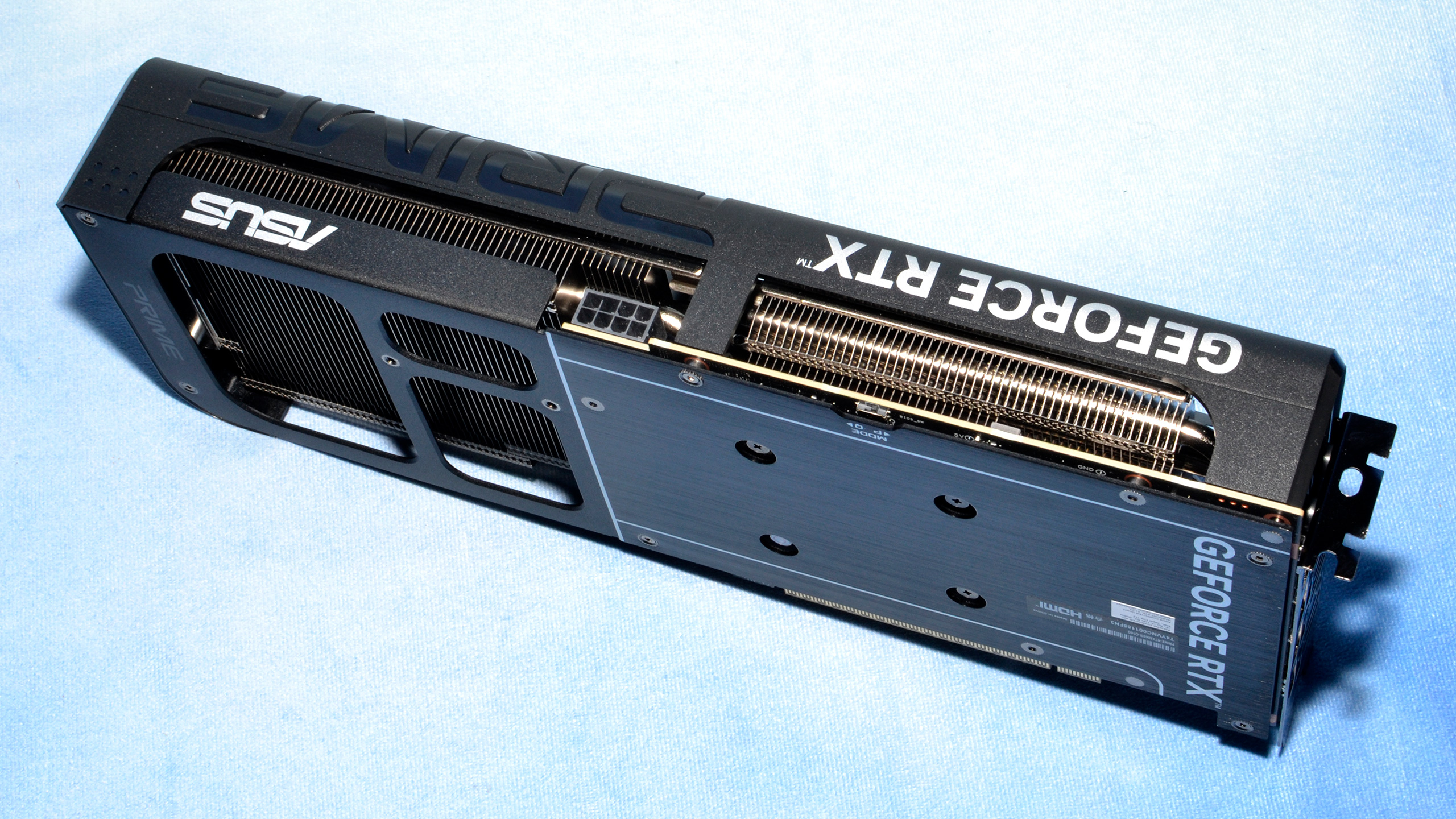
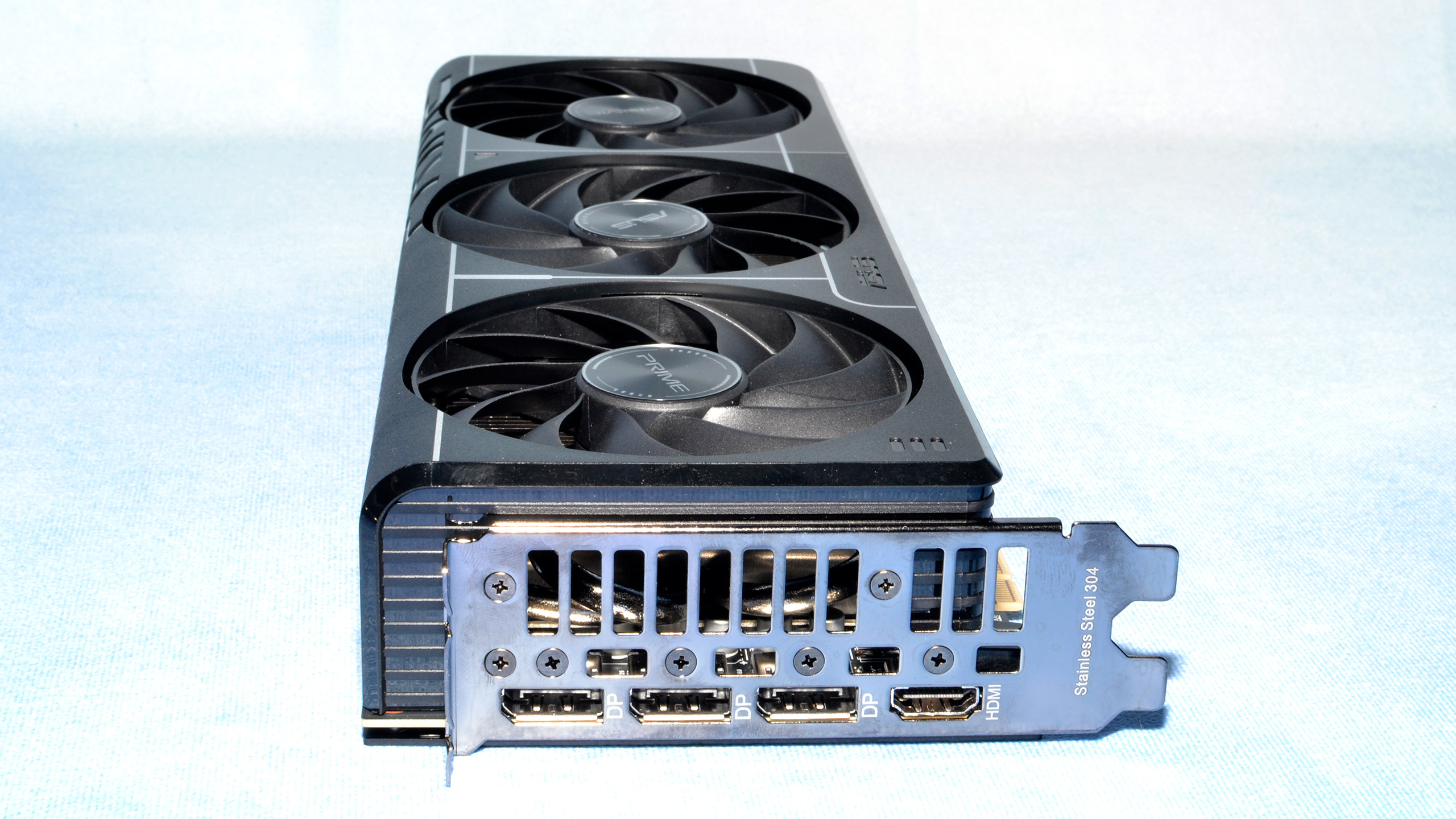
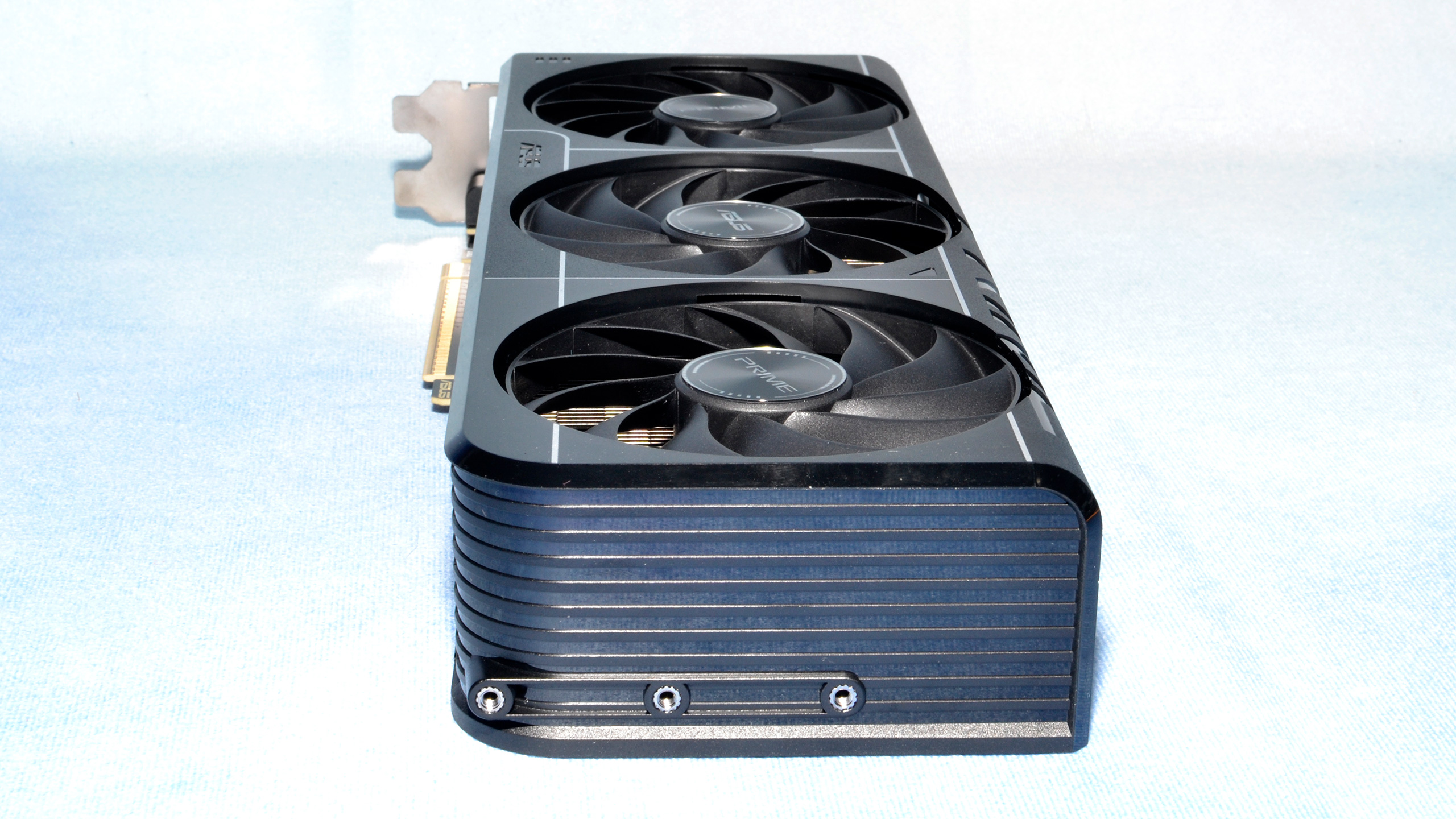
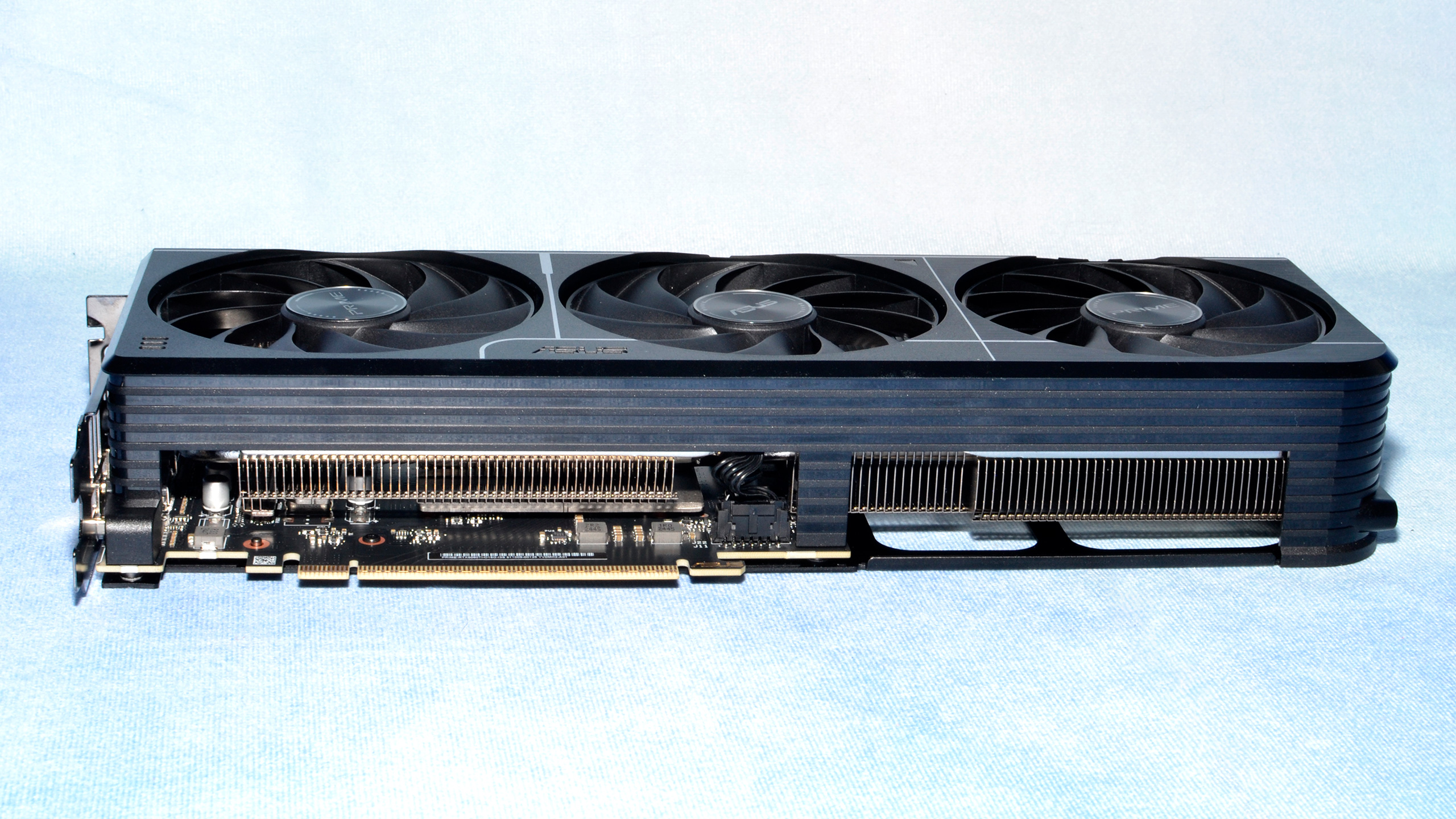
As with most modern consumer graphics cards, you get three DisplayPort 2.1b ports and a single HDMI 2.1b port. Nvidia's Blackwell GPUs support the full 80 Gbps maximum that DisplayPort 2.1 allows for, also called UHBR20 (Ultra High Bit Rate 20). The HDMI port only offers 48 Gbps by comparison, though both are capable of driving a 4K 240Hz monitor with DSC (Display Stream Compression) enabled.
Nvidia doesn't require its card partners to use a 16-pin 12V-2x6 power connector for cards that only need a single 8-pin connector. As such, the Asus Prime OC comes with a single 8-pin connector. Combined with the 75W maximum of the PCIe x16 slot, that's enough for 225W of total power. Across our full test suite, the maximum power draw we recorded for the card in any game at any resolution was 205W, while the average power peaked at 181W. (You can see the average power data on page nine.)
Like most graphics cards, Asus uses a physical PCIe x16 connector, even though it's electrically wired for x8 lanes. That's for the best, as it helps support the card and locks into the motherboard graphics slot.
Asus uses a flow-through design for the back fan, which also applies to half of the middle fan. There's also a dual-VBIOS switch to toggle between 'quiet' and 'performance' modes, which mostly affects the fan speed curve. Asus also has an aluminum shroud on the card, which can be removed separate from the heatsink assembly — useful for cleaning out the fans and radiator fins.
- MORE: Best Graphics Cards
- MORE: GPU Benchmarks and Hierarchy
- MORE: All Graphics Content
Get Tom's Hardware's best news and in-depth reviews, straight to your inbox.
Current page: Asus GeForce RTX 5060 Ti 16GB Prime OC
Prev Page Introducing the Nvidia GeForce RTX 5060 Ti 16GB Next Page PNY GeForce RTX 5060 Ti 16GB OC
Jarred Walton is a senior editor at Tom's Hardware focusing on everything GPU. He has been working as a tech journalist since 2004, writing for AnandTech, Maximum PC, and PC Gamer. From the first S3 Virge '3D decelerators' to today's GPUs, Jarred keeps up with all the latest graphics trends and is the one to ask about game performance.
-
Amdlova I want to say that is a nice card... But with 180w TBP for those numbers it's a waste of sand.Reply
nvidia is afraid to bench the 8GB cards... Just buy an AMD card and be happy -
palladin9479 Once the 8GB model comes out would be nice to see a quick article focusing just on 4060 and 5060 8 / 16 finding the settings where 8GB stops being capable. The 1080p medium graph shows that the 8GB cards work fine at that level, but then the next step is "ultra" which usually has ridiculous texture sizes. Would be nice to see 1080, 1440, 2160 "high" or "very high", one step down from ultra and see how well those cards do. Someone buying a xx60 class card isn't going to have a good experience playing at 4K "ultra".Reply
Amdlova said:nvidia is afraid to bench the 8GB cards... Just buy an AMD card and be happy
It's right in the article just compare both versions of the 4060. Each test has a graph at the very end using 1080p medium and you can see the 8GB model does very well there. They didn't have time to do additional testing with "high" or "very high" intermediate levels and ultra has ridiculously large texture sizes that start to hurt 8GB cards. I see them as doing well on 1080/1440 with "high" settings, basically a budget gamer using whatever they can get their hands on. We laugh but I know a ton of guys like that at work, have wives and kids are upgrade a piece at a time. -
JarredWaltonGPU Reply
In our test suite, 1080p ultra is still playable in all 18 games on an 8GB card, or at least an 8GB Nvidia card. (The RX 7600 may have some issues in one or two games.) There are however games like Indiana Jones where 8GB represent a real limit to the settings you can use. The TLDR is that it varies by game, but 1080p/1440p "high" should be fine on an 8GB card. I'd still pay the extra $50 if I were in the market for this sort of GPU (assuming it's only a $50 difference, naturally).palladin9479 said:Once the 8GB model comes out would be nice to see a quick article focusing just on 4060 and 5060 8 / 16 finding the settings where 8GB stops being capable. The 1080p medium graph shows that the 8GB cards work fine at that level, but then the next step is "ultra" which usually has ridiculous texture sizes. Would be nice to see 1080, 1440, 2160 "high" or "very high", one step down from ultra and see how well those cards do. Someone buying a xx60 class card isn't going to have a good experience playing at 4K "ultra". -
cknobman So the new gen 60 TI class card cant even come close to matching the last gen vanilla 70 class card?Reply
Seems like a really bad "upgrade" to me.
Definitely a 3 star, not 4, kind of score.
Also if you have been keeping up with the news Nvidia is purposely not letting 8gb cards get reviewed.
They told partners they are not allowed to sample those cards out for review.
The only way you will get 8gb card reviews is AFTER release and when they are purchased at retail by reviewers.
The only reason this is happening is because Nvidia knows the 8gb cards are crap. Making reviews wait until after retail availability ensures that at least the first batch will fly off shelves regardless.
Nvidia is a terrible company. -
palladin9479 ReplyJarredWaltonGPU said:In our test suite, 1080p ultra is still playable in all 18 games on an 8GB card, or at least an 8GB Nvidia card. (The RX 7600 may have some issues in one or two games.) There are however games like Indiana Jones where 8GB represent a real limit to the settings you can use. The TLDR is that it varies by game, but 1080p/1440p "high" should be fine on an 8GB card. I'd still pay the extra $50 if I were in the market for this sort of GPU (assuming it's only a $50 difference, naturally).
Yeah it's all price dependent $50 USD to go from 8 to 16 is a no brainer, but there is a large market for older stuff including used cards (see your other article). Steam survey has 1080p being 56.40% of the market with 1440p being 19.06%, that's 3/4ths of the gaming market between those two resolutions. 8GB VRAM was 35.52% with 12GB at 18.42 and 6GB at 11.93%. Over 60% of the market was 8GB or less and only ~7.2% had 16GB or more. We've obviously got a center mass of sorts around 1080/1440 with 8GB, kind of the definition of "mainstream" and why I'm interested in that bracket despite youtubers claiming that a 8GB card can't run solitaire in 2025.
It's not sexy but it's the vast majority of the consumer gaming market and with economies being what they are are prices going up, that market segment wants to squeeze as much out of it's limited disposable income as possible.
I mean RX 7600 8GB at $290 USD. Dirt cheap by todays standards. The poster child of "1080p medium/high".
https://www.amazon.com/PowerColor-Hellhound-Radeon-Gaming-Graphics/dp/B0C48LM7NN/ -
Alvar "Miles" Udell I'd say this is a 3 star card.Reply
Should have knocked a star off just because the 8gb model exists to up charge for the 16gb model.
The 19% rasterization performance improvement deserves another deduction because it is a terrible Gen over Gen increase, same across the 5000 series stack. Yes it's just a refinement generation, but even for MSRP you're talking over $400 for 1080p75/1440p60 in 2025 and not even matching last gens 4070, which will be made all the worse once custom editions tack on their upwards of $100 premiums.
Granted this is an upper entry level gaming card, a PC built around it is still very much more expensive than a console, and needs to have performance that justifies it. -
DRagor I have checked my local market. All 8Gb cards were sold out while 16Gb were still in stock, some even at MSRP (although many had price close to 5070 lol). For me it is clearly foul play by NVIDIA: let the ppl watch 16Gb version reviews and then go buy cheaper 8Gb models coe they're cheapo and ppl don't understand difference.Reply -
Gururu B580s are still in stock... So many similar cards tested from the big two, why not toss in the ARC B580 for buyer options? We know it sits in the 7600/4060 class or higher.Reply -
Roland Of Gilead Reply
Totally agree with you. I was kinda hoping the 5060ti would have a similar bump like the 3060ti did, being faster than a 2080 Super. I kinda figured from the reviews of the new gen 50xx models that it wouldn't really hit the point. But to do so, so unspectacularly is not good.cknobman said:So the new gen 60 TI class card cant even come close to matching the last gen vanilla 70 class card?
As pointed out, the 5060ti 16gb is the only choice for only $50 more. It's a no brainer.
I'm quite happy now with my 4070 Super, and have no FOMO. Well, maybe apart from the 9070XT, which I think is hands down the award winner in the last roll out of GPU's. Defo the stand out card right now, if they are available. -
ThereAndBackAgain Reply
Honestly, if people don't understand the difference between 8 GB VRAM and 16 GB VRAM, they shouldn't be spending $400+ on a GPU in the first place. But it's kind of hard to imagine someone knowledgeable enough to build their own PC not comprehending VRAM. The people who bought those cards most likely knew exactly what they were getting.DRagor said:I have checked my local market. All 8Gb cards were sold out while 16Gb were still in stock, some even at MSRP (although many had price close to 5070 lol). For me it is clearly foul play by NVIDIA: let the ppl watch 16Gb version reviews and then go buy cheaper 8Gb models coe they're cheapo and ppl don't understand difference.